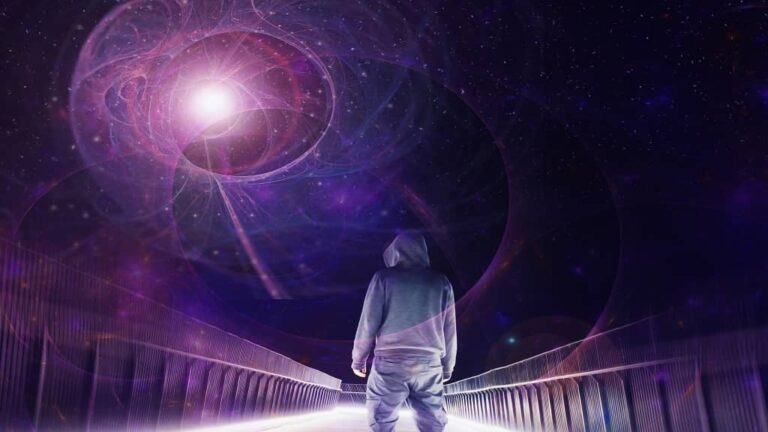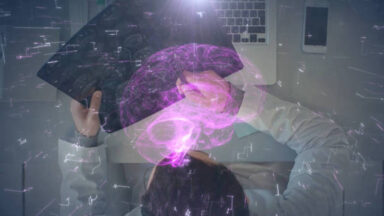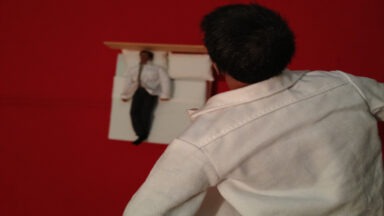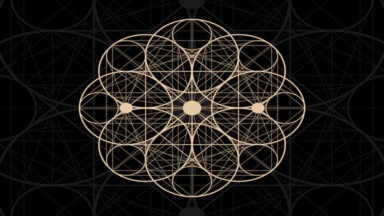Scientist Explains What Happens When People Channel

When you hear the word channeling, what comes to mind? Many of us would think of Bashar, Seth, Barbara Marciniak, Edgar Cayce, etc. In other words, most people think of trance channeling, where a person allows a supposed entity (deceased spirits, aliens, angels, higher self, etc.) to use their body as a vehicle to communicate.
I am a trained clinician, naturopathic physician, and Director of Research at the Institute of Noetic Sciences. I also happen to come from a long line of trance channelers and received a BIAL grant for researching the physiological effects of full-trance channeling:
As someone who bridges the worlds of scientific inquiry and the esoteric, I have a more encompassing definition for channeling:
“Channeling is the process of revealing information and energy not limited by our conventional notions of space and time that can appear receptive or expressive.” – from The Science of Channeling
One of the most confusing things about channeling is its name. Many people associate it with trance channeling. Others use it interchangeably with terms like psychic, medium, psi, ESP, etc. When I first engaged in conversation with people about these phenomena, I found that the terms meant different things to different people.
For example, as a naïve new researcher in the field, I formally reviewed the literature to understand the terms used for trance channeling. There were 29 different terms used to describe this form of channeling and the people who do it.
Multiple research studies show that channeling is experienced on a spectrum. On one side, you have widespread experiences like intuition and gut hunches. Telepathy, clairvoyance, and precognition lie somewhere in the middle. Rarer experiences like trance channeling and out-of-body experiences are on the far side of the spectrum. Channeling comes in so many forms.
At IONS, we call your unique way of channeling your Noetic Signature™. There is no right or wrong signature. All are beautiful and unique. Just as each snowflake is different yet equal in its exquisite beauty, each person’s Noetic Signature™ has inherent value.
An Overview of Channeling
In my book, The Science of Channeling: Why You Should Trust Your Intuition and Embrace the Force That Connects Us All, I share about the IONS Channeling Research Program and what we’ve learned by investigating these research questions:
- How common is channeling, and what are its characteristics?
- How does channeling work?
- Are there defining characteristics of someone who channels easily?
- Can we verify the information?
- Is the content useful?
In this blog post, I’d like to share an overview of these findings with you. You can also watch a video about some of our findings here.
How Common Is Channeling?
Not only are channeling abilities found in perfectly healthy people, but the experience of channeling is actually quite common.
In another study conducted by IONS, we surveyed scientists, engineers, the general public, and IONS members about their channeling experiences. We were surprised to find that of the 900 participants, a whopping 90% (93-99%) had at least one channeling experience in their lifetime.
This suggests that channeling experiences are common. In fact, Rapoport, Leiby-Clark, and Czyzewicz put out a survey each year to gather information on the number of Americans that believe in paranormal phenomena. What’s interesting is that this number has increased year over year.
One overarching theme in parapsychological research is that the more we believe in phenomena, the more likely we are to experience them. This could account for that growing number. That being said, some channeling experiences are more common than others.
I think of channeling as being like a spectrum. On the subtler side, people experience clairempathy, claircognizance, lucid dreaming, and telepathy. Somewhere toward the middle are precognition and mediumship. And at the far end of the spectrum are rarer experiences like trance channeling, geomancy, psychic healing, pyrokinesis, and levitation.
Is Channeled Information Real?
Channeling may be common — but is it real? “Real” would mean that channeling can be observed with objective measures rather than just anecdotal accounts.
Jessica Utts published an interesting statistic in a study featured in the Journal of Scientific Exploration. She showed us that the effects observed in ESP research are significantly larger than the effect size of 81 mg of aspirin therapy.
In other words: Many channeling phenomena appear to be very real.
Some evidence for channeling can be found in the work of Rupert Sheldrake. Sheldrake has compiled a database of 4,000 case histories, 2,000 questionnaires, 1,500 interviews, and more than a decade of controlled experiments — all of which indicate that consciousness is nonlocal and fundamental. He and many other scientists have conducted direct mental interactions with living systems (DMILS) experiments that show us a person (the sender) can remotely influence another person’s (the receiver’s) physiology.
In these studies, a sender directs positive intention toward the receiver. Both participants’ bodies are measured for physiological changes. The results are consistent: Small but significant effects can be observed in the physiology of the receiver. DMILS is probably why, for example, we can sense when someone is staring at us.
And yet the evidence for channeled information goes beyond any individual study. In the scientific world, a meta-analysis is the pinnacle of proof. A meta-analysis looks at general trends across many studies and yields an integrated result. These types of analyses are critical because they give a more precise estimate of effect size and may give us conclusive results where individual studies cannot.
Meta-analyses related to channeling illustrate that the evidence for psychic experiences are comparable to that of established phenomena in psychology.
So yes, we have good reason to believe that channeling is real. Which leads us to yet another question: How does channeling work?
How Does Channeling Work?
At this point, no one is sure exactly how channeling works. We understand bits and pieces but more research is needed.
Relative to other branches of science, psi research is notably lacking. On the one hand, this is exciting: Psi is a relatively untapped frontier. On the other hand, the field is underfunded. Additionally, these topics remain taboo in the scientific community.
With little funding (and the genuine possibility of staking one’s career), few scientists are willing to commit their time and energy to psi research (even though, behind the scenes, many are interested in this field!).
In any case, we are in the infancy of our understanding of extended human capacities. Right now, we just have ideas.
It appears as though channeling transcends time and space because the effects of psychic phenomena are instantaneous. For example, in Random Number Generator (RNG) studies, a generator produces random numbers. And yet, when a person directs their attention to the generator, the numbers become less random.
How is something like this possible?
All of parapsychology hinges on the idea that consciousness is nonlocal and fundamental; therefore, everything is interconnected. It’s as though we can all tap into a consciousness larger than the one we experience in our day-to-day life.
It also appears that our abilities to tap into this consciousness are limited by external stimuli. This is why meditation is often used to cultivate intuitive abilities: It’s about learning how to shut out the noise.
Where Does Channeled Information Come From?
We don’t understand all the mechanics of channeling yet…and we’re not sure where the information is coming from. We conducted a survey among channelers where participants were asked what they thought the source of their channeled information was. They were able to choose as many options as they wanted:
56% of participants thought the source of channeling was their higher self;
50% said the universal mind;
47% said the unconscious mind.
Fewer people reported channeling spirits, ETs, deities, or other entities.
Common Traits of Spiritual Channels
In our research, we have found that certain characteristics lend themselves to channeling.
First of all, believing that you can channel predicts that you will have more channeling experiences and do better on laboratory tests. In studies done in the West, women report stronger and more frequent experiences than men. This may be because women tend to carry more yin qualities. Yin is feminine energy. It is open, receptive, and connected. In these western studies, channelers also tend to describe themselves as “spiritual but not religious.” Other demographic information, such as age and race, have mixed results.
That being said, we believe that everyone can learn to channel.
What is your unique way of channeling? If you’re interested in discovering or further cultivating your channeling abilities, you can order a copy of The Science of Channeling. In it, I’ll show you how to identify and hone your own channeling skills, process the information you receive, and use your unique gift to improve your life — and the world around you.
Astral Journey: What It Is, How to Do It, and What You Can Discover

An astral journey is a fascinating practice in which consciousness detaches from the physical body to explore the astral plane, a dimension of existence beyond the tangible world. In this article, we will delve into how an astral journey can be consciously induced, explore the transformative benefits it offers, and demystify the risks commonly associated with this ancient experience.
Table of Contents
- What Is an Astral Journey and What Is It For?
- Differences Between an Astral Journey and a Lucid Dream
- Step-by-Step Guide for a Safe Astral Journey
- How to Return from an Astral Journey
- Benefits of Astral Travel
- Dangers of Astral Travel
- Advancing in Astral Travel Practice
- Integrating Astral Travel into Daily Life
What Is an Astral Journey and What Is It For?
An astral journey is an experience in which consciousness separates from the physical body and moves through the astral plane, a non-material dimension that coexists with the physical world. Although many people experience it unconsciously while sleeping, it is possible to learn how to consciously and voluntarily induce these journeys through specific techniques of relaxation, meditation, and visualization.
This practice allows individuals to explore realities beyond the physical senses. Those who have had conscious astral journey experiences often describe an expansion of perception, encounters with other forms of consciousness, and access to information that is not available in the usual waking state.
The astral journey can be a tool for spiritual development and self-knowledge. By transcending the limits of the physical body, the practitioner can gain a deeper understanding of the nature of being, overcome the fear of death, and strengthen the connection with their spiritual essence.
In the third season of Mystery Teachings, available on Gaia, an entire episode is dedicated to astral journeys. There, Theresa Bullard shares effective techniques for initiating in the astral plane, addressing what should and should not be done, and demystifying several myths associated with the journey through the astral realms.
Differences Between an Astral Journey and a Lucid Dream
Although they may seem similar, an astral journey and a lucid dream are distinct experiences. In a lucid dream, the person becomes aware that they are dreaming and can control certain elements of the dream, but remains within the dream plane generated by the mind. In contrast, an astral journey involves the separation of consciousness from the physical body to explore a real and external plane, different from the internal world of dreams.
Additionally, the purpose and experience also differ. While lucid dreaming often has a recreational or symbolic component, the astral journey has a more experiential and spiritual nature. The level of clarity, intensity, and perception of reality in the astral plane is notably higher than in dreams, and the experiences obtained can have a profound impact on the practitioner’s daily life.
Step-by-Step Guide for a Safe Astral Journey
To have a safe astral journey, it is essential to follow a structured practice that combines mental preparation, physical relaxation, and visualization techniques. In Mystery Teachings, Theresa Bullard presents a progressive method that can be integrated into the daily routine as training. This step-by-step guide helps to induce astral projection gradually, consciously, and safely, allowing the practitioner to explore the astral plane with greater clarity and confidence.
- Preparatory meditation: Dedicate 15 minutes a day to meditate with your back straight. This posture favors the energy flow through the chakras and allows you to reach a receptive mental state.
- Initial visualization: Observe a white dot on a black background or vice versa. Then close your eyes and try to keep a clear mental image of the dot.
- Daily visual training: Practice this visualization every day for a week. This strengthens concentration and trains the mind to sustain images in deep relaxation states.
- Expansion of the dot: In the second week, mentally expand the visualized dot until it transforms into a large space. This space represents the threshold between the physical and the astral plane.
- Tunnel formation: Imagine that this space turns into a tunnel connecting both planes. Visualize yourself entering this transitional tunnel with your consciousness.
- Visualized destination: At the end of the tunnel, mentally create a specific place you want to reach. Keep your intention clear and use that goal as an anchor for the astral experience.
- Conscious movement: Move through the astral plane using the speed of thought. This form of movement allows you to explore the environment fluidly and without physical effort.
How to Return from an Astral Journey
The return to the physical body after an astral journey usually occurs naturally, as consciousness is permanently connected to the body through what many practitioners describe as the “silver cord.” In most cases, it is enough to direct attention toward the physical body or internally express the intention to return for the process to occur immediately. This reconnection is usually smooth, although some people may experience sensations of vibration or a slight jolt upon returning.
However, there are simple techniques that can facilitate a more conscious and gradual return. Slightly moving the fingers of the hands or feet, taking a deep breath, or visualizing the physical body as an anchoring point are effective methods to reintegrate without abruptness. With practice, the return to the body becomes increasingly natural, allowing the experience to be concluded in a balanced way and wakefulness to be resumed with clarity and stability.
Benefits of Astral Travel
Astral travel offers a wide range of spiritual and personal benefits, allowing practitioners to explore beyond physical limitations and gain new perspectives on life and existence. Reaching these states of consciousness can result in a profound sense of liberation and knowledge, alleviating fears such as the fear of death and strengthening the connection with the higher self and spiritual dimensions.
- Expansion of consciousness: Astral travel allows one to experience a broader reality beyond daily life, promoting greater mental openness and flexibility in thinking.
- Understanding life after death: Practicing astral projection can provide comfort and insight into what might exist beyond physical life, reducing the fear of death.
- Development of psychic abilities: Through astral travel, some people report an increase in their intuitive and psychic abilities, such as clairvoyance or extrasensory perception.
- Emotional healing: Consciously revisiting past experiences from an astral perspective can provide new understanding that helps in the emotional healing process.
- Increased creativity: Astral travel can inspire individuals by giving them access to visions and ideas beyond the reach of conventional thought.
Dangers of Astral Travel
Although astral travel is safe, there are certain myths that may cause concern among practitioners. It is important to clarify these myths to ensure that participants feel comfortable and secure during their astral experiences. Understanding that these “dangers” are largely unfounded can help practitioners approach astral travel with confidence and peace of mind.
- Fear of not returning to the physical body: A common myth is the fear of getting stuck in the astral plane and not being able to return to the physical body. However, the so-called “silver cord,” which connects the astral body to the physical body, is not something that can be broken. Instead, it is a metaphorical connection that always ensures the return to the body.
- Encounters with negative entities: Some practitioners express concern about encountering malicious entities during their travels. Protecting oneself with light visualizations and setting clear and firm intentions for safety before the journey can help avoid these experiences and ensure a positive astral environment.
- Disorientation and fear: For beginners, it is common to feel some disorientation or fear when exploring astral experiences for the first time. These feelings are usually mild and can be easily managed with practice and preparation. Learning control techniques and cultivating a positive mental environment before starting the journey can help overcome these moments and improve the overall experience.
Advancing in Astral Travel Practice
For those interested in deepening their astral travel practice, it is essential to develop a consistent routine and employ advanced meditation and visualization techniques. As practitioners gain more experience, they can begin to explore various aspects of the astral plane with greater control and purpose. This includes learning to navigate to specific locations, interact with different spiritual entities, and receive teachings or guidance.
Additionally, sharing experiences with a community of practitioners can be invaluable. Joining groups or workshops where techniques and personal experiences are discussed helps validate and enrich one’s journey in astral travel. The guidance of an experienced mentor can also be a great advantage, offering the opportunity to learn through direct teaching and receive feedback that is crucial for personal and spiritual growth in this practice.
Integrating Astral Travel into Daily Life
Integrating astral travel into daily life means more than just having out-of-body experiences; it involves applying the perceptions and teachings obtained during these journeys to everyday physical existence. For example, insights gained about personal challenges or behavioral patterns can be used to improve relationships, make more informed decisions, and cultivate greater inner peace.
On the other hand, regularly practicing astral travel can foster a sense of spiritual connection and purpose that transcends mundane activities. This may manifest as greater empathy toward others, a commitment to service or community, and an interest in additional spiritual practices that complement personal growth. For those who deeply integrate these practices, astral travel becomes a way of life that fully embraces the multidimensional nature of human existence.





































